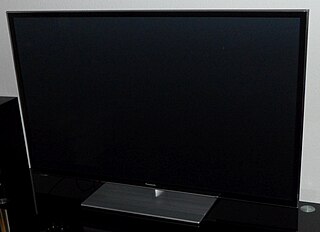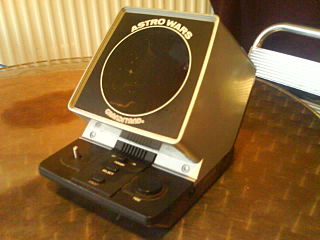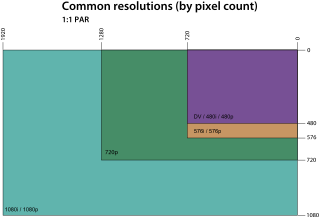
A handheld game console, or simply handheld console, is a small, portable self-contained video game console with a built-in screen, game controls and speakers. Handheld game consoles are smaller than home video game consoles and contain the console, screen, speakers, and controls in one unit, allowing players to carry them and play them at any time or place.

A liquid-crystal display (LCD) is a flat-panel display or other electronically modulated optical device that uses the light-modulating properties of liquid crystals combined with polarizers to display information. Liquid crystals do not emit light directly but instead use a backlight or reflector to produce images in color or monochrome.

Pac-Man, originally called Puck Man in Japan, is a 1980 maze video game developed and released by Namco for arcades. In North America, the game was released by Midway Manufacturing as part of its licensing agreement with Namco America. The player controls Pac-Man, who must eat all the dots inside an enclosed maze while avoiding four colored ghosts. Eating large flashing dots called "Power Pellets" causes the ghosts to temporarily turn blue, allowing Pac-Man to eat them for bonus points.

A plasma display panel is a type of flat-panel display that uses small cells containing plasma: ionized gas that responds to electric fields. Plasma televisions were the first large flat-panel displays to be released to the public.
The Game Axe is an unlicensed handheld version of the Famicom, made by the Taiwanese hardware manufacturer Legend Technology Co., LTD. Launched in 1989 it made a comeback around 2000, being sold in Hong Kong, Taiwan, and Japan under the Redant brand. It is a portable Famiclone that can play Famicom games, and by using the included adapter, American and European Nintendo Entertainment System games.

The Sharp PC-1211 is the first pocket computer ever released, marketed by Sharp Corporation in March 1980. The computer was powered by two 4-bit CPUs laid out in power-saving CMOS circuitry. One acted as the main CPU, the other dealt with the input/output and display interface. Users could write computer programs in BASIC.

Handheld electronic games are interactive electronic games, often miniaturized versions of video games, that are played on portable handheld devices, known as handheld game consoles, whose controls, display and speakers are all part of a single unit. Rather than a general-purpose screen made up of a grid of small pixels, they usually have custom displays designed to play one game. This simplicity means they can be made as small as a smartwatch, and sometimes are. The visual output of these games can range from a few small light bulbs or LED lights to calculator-like alphanumerical screens; later these were mostly displaced by liquid crystal and vacuum fluorescent display screens with detailed images and in the case of VFD games, color. Handhelds' popularity was at its peak from the late 1970s into the early 1990s before declining. They are the precursors to the handheld game console.

The Epoch Game Pocket Computer is a second-generation handheld game console released by Epoch Co. in Japan in 1984 for 12,800 Japanese yen. It is also known as Pokekon and was the first handheld console to feature interchangeable cartridges, preceding the Game Boy by 5 years.
A dedicated console is a video game console that is limited to one or more built-in video game or games, and is not equipped for additional games that are distributed via ROM cartridges, discs, downloads or other digital media. Dedicated consoles were popular in the first generation of video game consoles until they were gradually replaced by second-generation video game consoles that use ROM cartridges.
Several LCD games based on the video game series The Legend of Zelda have been released. The first, Zelda, released in 1989, was developed and manufactured by Nintendo; later LCD games were licensed to other developers. The Legend of Zelda game watch (1989) is a wristwatch game produced by Nelsonic as part of their Nelsonic Game Watch series. Zelda no Densetsu: Kamigami no Triforce is a fighting game produced by Epoch Co. for the Barcode Battler II, and was released only in Japan.

Pac-Man Championship Edition is a 2007 maze video game developed and published by Namco Bandai Games for the Xbox 360. It has since appeared on several other platforms, including iOS, Android, and the PlayStation 3 and PlayStation Portable as a PSP mini title available on the PlayStation Store. It is an HD reimagining of the original Pac-Man arcade game; players navigate Pac-Man through an enclosed maze, eating pellets and avoiding four ghosts that pursue him. Clearing an entire side of the maze of dots will cause a fruit item to appear, and eating it will cause a new maze to appear on the opposite side.

Nintendo Mini Classics are a series of small LCD games licensed by Nintendo in 1998. Most games in the series are reissues of Game & Watch titles, but the series does include titles that were not from the original Game & Watch line, like Spider-Man, Carrera and Yu-Gi-Oh!.

Astro Wars is an electronic table top game made in Great Britain in 1981 by Grandstand under licence from Epoch Co., who sold the game in Japan as Super Galaxian (スーパーギャラクシアン), and in the United States as Galaxy II. The game originally used a red logo on the housing; it was later switched to white.
Display lag is a phenomenon associated with most types of liquid crystal displays (LCDs) like smartphones and computers and nearly all types of high-definition televisions (HDTVs). It refers to latency, or lag between when the signal is sent to the display and when the display starts to show that signal. This lag time has been measured as high as 68 ms, or the equivalent of 3-4 frames on a 60 Hz display. Display lag is not to be confused with pixel response time, which is the amount of time it takes for a pixel to change from one brightness value to another. Currently the majority of manufacturers quote the pixel response time, but neglect to report display lag.

Grandstand is a video game console and electronic game manufacturer and distributor. It was based in the United Kingdom and New Zealand and was active in the 1970s and 1980s.

Munchman is a tabletop electronic game that was released under licence in 1981 in the UK by Grandstand. It is a rebadged version of the Tomy game known as Pac Man in the United States and Puck Man in Japan. The games are all based on Namco's Pac-Man arcade game and use a VFD screen.
The Mi2, also branded as PDC Touch, is a handheld game console developed and created by Dutch company Planet Interactive in Benelux and branded as Mi2. The Chinese manufacturer Conny Technology and the French manufacturer Videojet branded it as PDC Touch Media in France, Germany, Spain, Portugal and the UK. It was released in October 2009, being the successor of the Pocket Dream Console from 2005.
Nelsonic Industries is an American electronics manufacturing and development company that operated from Long Island City, Queens, New York City in the early 1980s and throughout the 1990s when it was acquired by the watch-manufacturer, M.Z. Berger. Nelsonic produced numerous toy-themed wristwatches, often targeting younger audiences with likenesses of characters from popular franchises such as Barbie, the Ghostbusters, and Mario. Nelsonic became notable during the early mid-1980s for being the first electronics company in the United States to produce game-watches. For a period subsequent to its purchase by M.Z. Berger, Nelsonic operated as a subsidiary division of its parent company and game-watches were produced that bore the Nelsonic mark. This practice ended as M.Z. Berger shifted focus to more traditional and higher-end timepieces. Today the original Nelsonic Game Watch line has entered the secondary market and individual Game Watches have become highly sought-after collectibles that often fetch high prices on eBay and other online auction websites.

A display resolution standard is a commonly used width and height dimension of an electronic visual display device, measured in pixels. This information is used for electronic devices such as a computer monitor. Certain combinations of width and height are standardized and typically given a name and an initialism which is descriptive of its dimensions.

The Casio CA-53W is a digital calculator watch manufactured by the Japanese electronics company Casio and was introduced in 1988 as a successor to the CA-50. It became famous for its appearance in the American science fiction films Back to the Future Part II (1989) and Back to the Future Part III (1990) and later for appearing in the American TV series Breaking Bad (2008–2013).














